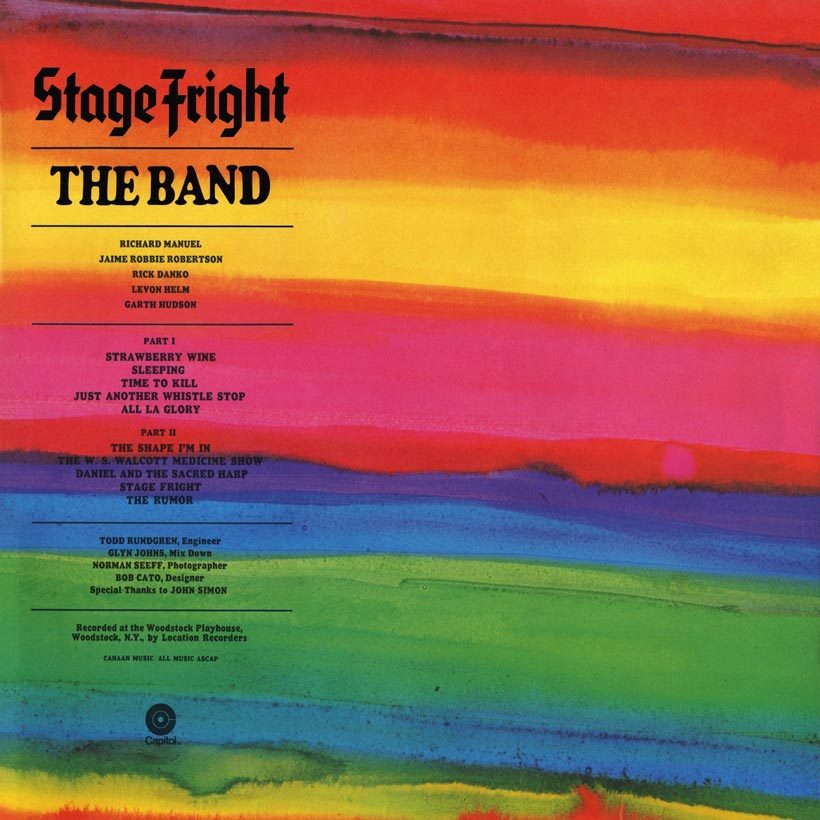‘Stage Fright’: A Candid Reflection Of The Band’s ‘Psychological Weather’
After inventing Americana with their first two albums, The Band captured a snapshot of themselves with the personal reflections of ‘Stage Fright.’

By the time The Band came to record their third album, in May 1970, expectations were high. They had already been Bob Dylan’s backing group and then broken out on their own to play an integral role in changing the direction of American music with their 1968 masterpiece, Music From Big Pink, and its self-titled follow-up. Judging by its title, Stage Fright suggested the group knew they’d have even more to prove.
As a gesture to the residents of Woodstock – who had endured some of the problems of living in a town that played home to famous musicians – The Band offered to record Stage Fright in a private town concert. The proposal was rejected by the local council, and so the group recorded the album at the Woodstock Playhouse without an audience. Young engineer Todd Rundgren was in charge of the acoustics, and guitarist/vocalist Robbie Robertson said, “It turned out to be an interesting acoustical thing because you could perform with the curtain closed and it would give you this dry sound and if you opened the curtain you got the sound of the house in there.”
Though The Band had privacy to be creative, the anxieties of fame and celebrity are evident in the themes of fear and alienation that permeate Stage Fright, which was released on August 17, 1970.
The songs are more personal than those of their first two albums, and an undoubted highlight is the title track, a candid song about Robertson’s struggle with stage fright. He turns his fears about performing for an audience into a universal lament. Robertson said, “In ‘Stage Fright’ a lot of stuff I was trying to hold in was starting to creep out.” Bassist and fiddle player Rick Danko takes lead vocals on the song and delivers a powerful performance, ably supported by Garth Hudson’s fluent organ playing.
Stage Fright continued to highlight The Band’s virtuosity. Hudson also played electric piano, accordion, and tenor and baritone saxophones on the record, while Levon Helm played drums, guitar, and percussion (and sang lead vocals on four songs), and Richard Manuel played piano, organ, drums, and clavinet.
All that instrumental talent, together with Manuel’s skill as a singer, came together on “Sleeping,” a Robertson-Manuel composition that blends rock and jazz inflections into a ruminative gem. That pairing also co-wrote “Just Another Whistle Stop,” which races along in zestful Band style, while the mood darkens again on “The Shape I’m In” and the catchy “The WS Walcott Medicine Show.” The bleak “Daniel And The Sacred Harp” is a parable about a musician selling his soul: “The moment of truth is right at hand/Just one more nightmare you can stand.” Robertson, who wrote the song, said he was trying to convey how helpless and vulnerable things seemed for the musicians at the time.
Helm sings tenderly on Robertson’s poignant lullaby of “All La Glory,” which he wrote for his child. Hudson’s graceful accordion playing brings out the best from moving lyrics, while “The Rumour,” one of seven songs Robertson is credited with writing solo, is another strong offering.
In their 1970 review, Rolling Stone magazine called the album “elusive.” Indeed, Stage Fright has the uncertainty of a record made at a time when the bonds between the band members were being tested by personal and professional frictions. “It was a dark album,” Helm admitted later. “And an accurate reflection of our group’s collective psychic weather. We all realized something was wrong, that things were beginning to slide.”
However, as a piece of music, it stands the test of time. And the public loved it at the time as well. Stage Fright reached a career-best position of No.5 in the album charts and went gold after selling more than half a million copies.













Janice Bays
August 19, 2022 at 11:58 pm
Blessed to have an original copy of Stage Fright that you so accurately reviewed. This album should be in everyone’s collection.